Biopsychology
1/288
There's no tags or description
Looks like no tags are added yet.
Name | Mastery | Learn | Test | Matching | Spaced |
|---|
No study sessions yet.
289 Terms
What is the nervous system?
Complex network of nerve cells (neurons) which carry messages from brain and spinal cord to different areas in the body.
Its divided into central nervous system (CNS) and peripheral nervous system
What is the central nervous system (CNS)?
Controls behaviour and regulates the bodies physiological processes
What is the peripheral nervous system?
Transmits messages via millions of neurons to and from the CNS and consists of the autonomic nervous system and somatic nervous system
What is the CNS made out of?
Brain and spinal cord
What is the peripheral nervous system split into?
Somatic and autonomic nervous systems
What is the somatic nervous system?
Receives info from sensory receptors and controls muscles
What is the autonomic nervous system?
Governs vital functions e.g. breathing
What is the autonomic nervous system broken into?
Sympathetic NS (fight or flight) and the parasympathetic NS (everyday state)
What is the function of the brain?
Command centre for human nervous system
Receives input from sensory organs and sends output to muscles
What is the organisation of the brain?
Cerebrum, cerebellum, diencephalon and brain stem
What is the function of the spinal cord?
Relay info between brain and rest of body
What is the organisation of the spinal cord?
Made up of pairs of spinal nerves which connect to specific muscles and glands in the body
Label the outside of the brain + diencephalon
The diencephalon is inside the brain in the temporal lobe and contains the thalamus and hypothalamus
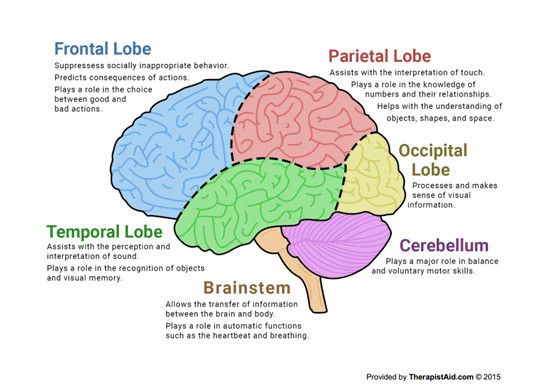
What is the frontal lobe?
Front of brain, controls thoughts, decisions and speech production
What is the cerebrum?
Main part of brain, split down middle into two hemispheres connected by corpus callosum
What is the occipital lobe?
Back of brain, controls processing visual info
Whats the cerebellum?
Bottom of brain, controls balance, motor skills and coordinating muscles
What is the diencephalon?
Inside brain on top of brain stem. Contains thalamus and hypothalamus
What is the thalamus?
Relay station for nerve impulses coming from senses and sending them to appropriate areas if brain to be processed
What is the hypothalamus?
Regulates important body functions e.g. body temp and hunger, it links nervous and endocrine systems and controls release of hormones from pituitary glands
What is the brain stem?
Bottom of the brain, connects brain and spinal cord, regulates automatic functions that are essential for life like breathing. Motor and sensory neurons travel through brain stem, allowing impulses to pass between brain and spinal cord
What are the divisions of the peripheral nervous system?
Somatic and autonomic nervous systems
What is the somatic nervous system?
Regulates voluntary actions e.g. muscles and movement.
Has sensory pathways that relay messages from sensory receptors to CNS and motor pathways that relay messages from the CNS to muscles and glands
What is the autonomic nervous system?
Regulates involuntary actions e.g. heart beat and digestion. Only has motor pathways that relay messages from the CNS to muscles and glands.
Divisions of ANS: sympathetic and parasympathetic nervous systems
What is the sympathetic nervous system?
Dilates pupils
Accelerates heartbeat
Dilates bronchi
Secretion of adrenaline
Occurs when there’s a threatening stimulus causing the fight or flight response
What is the parasympathetic nervous system?
Constricts pupils
Slows heartbeat
Constricts bronchi
Stimulates flow of saliva
Occurs in normal state
What is the structure of a neuron
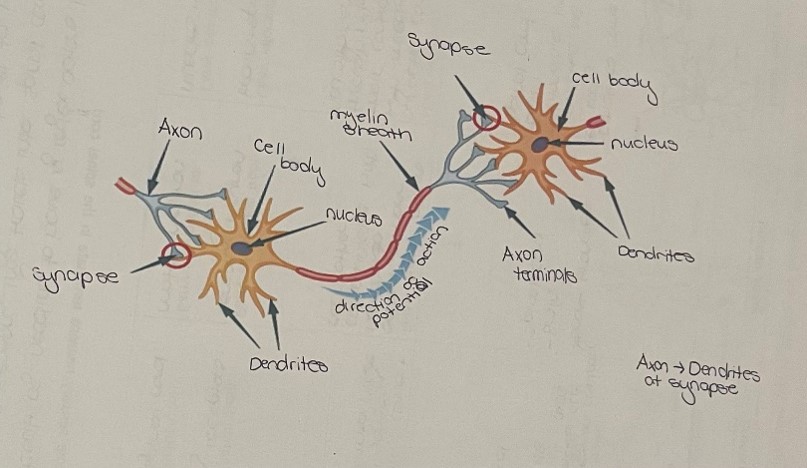
What is the structure of a sensory neuron?
No dendrites on cell body, cell body sticks out axon
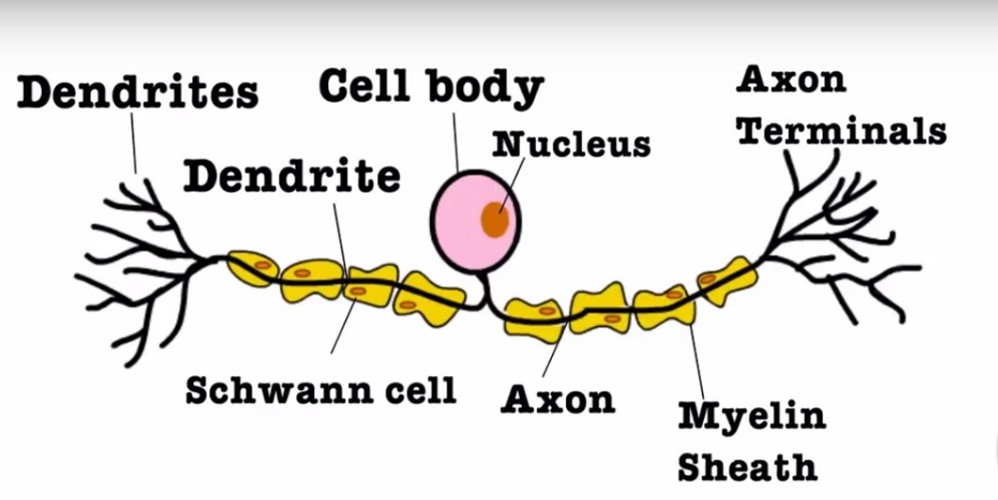
What is the location of sensory neurons?
Somatic nervous system, brain and spinal cord
What is the function of sensory neurons?
Convert info from sensory receptors into nerve impulses.
Carry info from sensory receptors to brain and spinal cord
Why do some sensory neurons terminate in the spinal cord?
Because of the need to have reflex actions.
In urgent situations when sensory info travels into spinal cord needing quick reactions, no time for nerve impulse to travel to brain
The sensory neurons terminate here to send quick messages quickly to motor neuron, via relay neuron, to ensure a quick motor response
What is the structure of a relay neuron?
Short branches
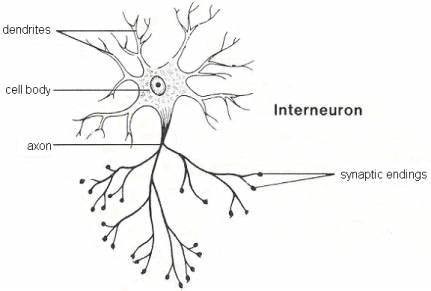
Where can relay neurons be found?
Brain and spinal cord
What is the function of relay neuron?
Allow sensory and motor neurons to communicate with each other
Carry info from sensory neuron to motor neurons
What is the structure of motor neuron?
Dendrites come off cell body
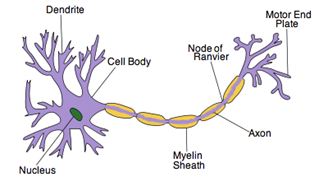
Where can motor neurons be found?
Somatic nervous system, autonomic nervous system, brain and spinal cord
What is the function of motor neurons?
Form synaptic connections with muscles and control their contradictions through release of neurotransmitters
Carry info from brain and spinal cord to muscles and glands
What is synaptic transmission?
Process by which a nerve impulse passes across synaptic cleft that lies between the axon terminal of one neuron and the dendrite or cell body of another neuron
The whole process takes only a fraction of a second and its effects are terminated through reuptake or enzymatic degradation
What is the process of synaptic transmission?
Synthesis. Neurotransmitter molecules are synthesised by precursors under influence of enzymes
Storage. Neurotransmitter molecules are stored in vesicles
Release. Action potential causes vesicles to fuse with presynaptic membrane and release molecules into synapse (gap between axon and dendrites)
Binding. Released neurotransmitter molecules bind to postsynaptic receptors in lock and key way
Removal. Released molecules removed so they stop activating receptors through reuptake (molecules taken back into presynaptic neuron) or enzymatic degradation
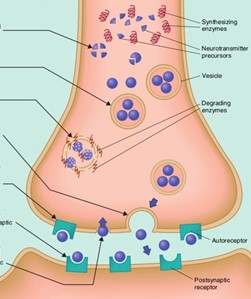
What are neurotransmitters?
Chemical messengers that carry impulses across the synaptic cleft to the receptor site on post-synaptic neuron
They are either classified as excitatory (switch on post-synaptic neuron) or inhibitory (switch off)
What are excitatory neurotransmitters?
Examples: acetylcholine and noradrenaline
Binding of excitatory neuron to receptors = ESPS (excitatory postsynaptic potentials)
Increases likelihood of post-synaptic neuron firing
What is inhibitory neurotransmitters?
Examples: GABA and serotonin
Binding of inhibitory neurotransmitters to receptors = ISPS (inhibitory postsynaptic potential)
Decreases likelihood of post-synaptic neuron firing
What is summation?
Excitatory and inhibitory postsynaptic potentials are summed
If net effect on postsynaptic neuron is inhibitory, neuron will be less likely to fire or will not fire at all whereas if net is excitatory neuron is more likely to fire
Two types of summation: spatial (input from multiple presynaptic cells) and temporal (high frequency of action potentials)
What is the endocrine system?
Network of glands throughout the body that manufactures and secrete chemical messengers known as hormones
Works with nervous system, although transmits messages via bloodstream not nervous system
What are endocrine glands?
Special groups of cells within the endocrine system which produces and secretes hormones
What are hormones?
Chemicals that are selected by endocrinal glands into bloodstream, which send messages to target cells in different parts of body
Label the main features of endocrine system?
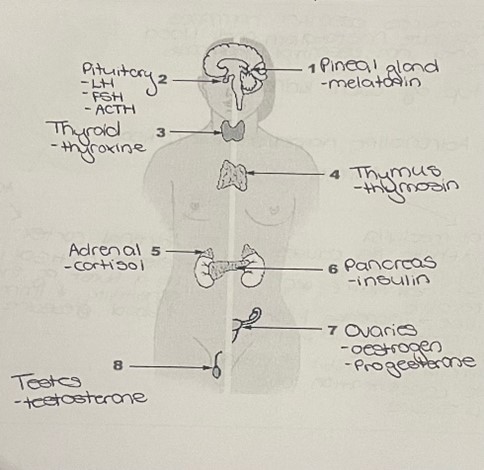
What is the function and location of the pituitary gland?
Function: produces hormones which directly stimulate target cells in body or stimulate other glands to produce hormones
Location: brain, below hypothalamus
Hormones produced: LH, FSH, ACTH, oxytocin
What are the two sections of the pituitary glands?
Anterior and posterior
What is the anterior section of pituitary gland?
FSH and LH sends message to ovaries to release progesterone and oestrogen (in women)
LH and FSH sends messages to testies to produce testosterone (in men)
ACTH stimulated to produce adrenal cortex to release cortisol
What is the posterior section of pituitary gland?
Oxytocin creates bonds between parent and child and contractions of the uterus after birth
What is the function and location of adrenal glands?
Function: produces essential hormones which regulate metabolism, blood pressure and non-essential hormones in response to stress
Located: top of each kidney
Hormones produced: adrenaline, noradrenaline, cortisol
What are the two sections of adrenal gland?
Adrenal medulla and adrenal cortex
What is the adrenal medulla?
Sympathetic NS causes adrenal medulla to release adrenaline and noradrenaline
Adrenaline increases heart rate and conversion of glycogen to glucose
Noradrenaline inhibits digestion, increases concentration and blood pressure
What is the adrenal cortex?
ACTH triggers to release of cortisol which gives us a burst of energy, decreases pain sensitivity, decreases immune functioning and increases blood pressure
What is the fight or flight response?
Sequence of bodily responses that are activated when a person experiences a threatening or stressful situation.
The bodily changes caused by this response allow individuals to respond quickly to life threatening situations by preparing them to attack (fight) or run to safety (flight)
What are the first few steps of the fight or flight response?
The stressor sends a message to the amygdala (inside brain) which sends message to hypothalamus that there is a threat.
Hypothalamus either decides the threat is acute (short term) or chronic (long term)
What happens if the hypothalamus decides the stress is acute?
There is a switch from parasympathetic NS to sympathetic NS.
Sympathetic NS sends message to spinal cord which makes saliva glands decrease saliva, muscles increase strength and speed and adrenal medulla to produce adrenaline and noradrenaline.
Adrenaline increases breathing and heart rate to ensure we get enough oxygen, dilates pupils to improve vision and increase glucose supply for energy to run
Noradrenaline constricts blood vessels to increase pressure for increased heart beats.
Switch back to parasympathetic NS/state
What happens if the hypothalamus decides the stress is chronic?
CRH is released.
This stimulates anterior part of pituitary gland which releases ACTH.
This stimulates adrenal cortex to produce cortisol
Cortisol decreases sensitivity to pain, maintains steady supply of glucose, increases blood pressure and inhibits production of white blood cells
What is the role of adrenaline in fight or flight response?
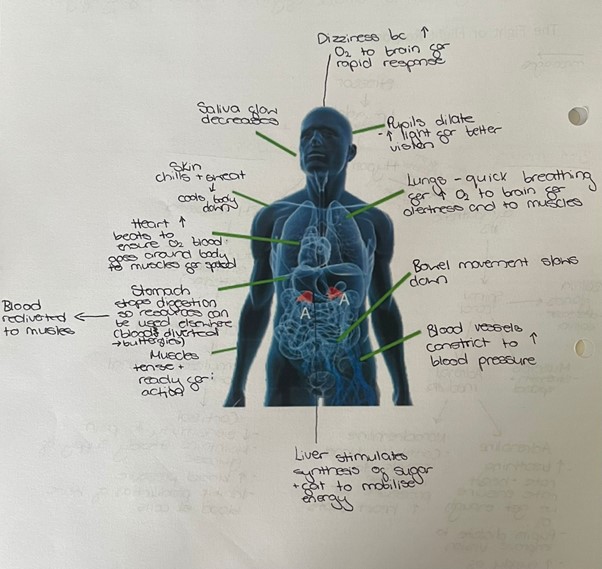
What do functional magnetic resistance imaging (fMRI’s) measure?
fMRI measures neural activity in the brain when performing a task by measuring changes in blood oxygenation and flow as when an area of the brain is more active it consumes more O2. The increased demand for oxygen results in increased blood flow to the area of the brain
What are fMRI’s used for?
It’s used to produce maps showing which parts of the brain are involved mental processes.
This has important implications for understanding localisation of function
What is a strength of fMRI’s?
Risk-free procedure. This is because its non-invasive as no instruments are inserted and unlike other scanning techniques such as PET scans does not rely on use of radiation
What is another strength of fMRI’s?
Objective and reliable measure of brain activity. This is because fMRI produces images that have high resolution and depict details of brain activity by the millimetre
What is a limitation of fMRI’s?
Not a direct measure of neural activity. This is because fMRI only measures changes to blood flow, which means its difficult to tell what kind of brain activity is being represented
What is another limitation of fMRI’s?
Poor temporal resolution. This is because there is a 5 second lag behind the image on the screen and initial firing of neuronal activity
What do electroencephalogram (EEG’s) measure?
EEGs measure electrical activity generated by neurons in the brain by placing electrodes on the scalp which detects small electrical charges generated by neuronal activity.
Electrical signals from electrodes are graphed over time and the resulting representation is known as an EEG
What are EEG’s used for?
Used to detect brain diseases, tumours, injuries or disorders e.g. epilepsy.
For example, EEG readings of epilepsy patients show spikes of electrical activity
What is a strength of EEGs?
Useful in clinical diagnosis. This is because epileptic seizures are caused by disturbed brain activity that shows up on EEG. Therefore, helps work out whether seizures are caused by epilepsy (not something else) which is useful for a diagnosis
What is another strength of EEGs?
High temporal resolution. This is because it measures activity within 1-10 milliseconds of when it happens. Gives precise readings of brain activity. Thus, the speed of EEGs are useful for researchers
What is a limitation of EEGs?
Only detects superficial activity. This is because the electrodes only measure activity in immediate area. Thus, can only measure activity near surface of the brain
What is another limitation of EEGs?
Fails to pinpoint exact source of an activity. This is because electrical activity can be picked up by several neighbouring electrodes so cannot be used to say exactly what specific area is active. Thus, in some cases, EEGs lack value as they are a vague measure that doesn’t show precise measurements of the brain
What do event-related potentials (ERPs) measure?
ERPs measure the brains electrophysical response to a specific sensory, cognitive and motor event by presenting the stimulus many times and averaging the responses.
Extraneous neural activity not related to the specific stimulus will be inconsistent and therefore will be filtered from the original EEG recording.
This leaves only the responses that relate to specific stimulus
What are ERPs used for?
ERPs are used to investigate how ERPs link to cognitive processes such as attention and memory
What is a strength of ERPs?
Specific measurements of neural processes.
This is because ERPs provide a continuous measure of processing in response to particular stimulus, it makes it possible to determine how processing is affected by a specific experimental manipulation, for example during presentation of different visual stimuli
What is another strength of ERPs?
High temporal resolution. This is because it measures activity within 1-10 milliseconds of when it happens.
Gives precise readings of brain activity. Thus, the speed of EEGs are useful for researchers
What is a limitation of ERPs?
Requires large number of trials to gain meaningful data. This is because changes in brain activity after a trigger are small and difficult to separate out from other electrical activity in the brain. Thus, lots of trials have to be conducted and results averaged to cancel out effects of background electrical activity which is time consuming and expensive
What is another limitation of ERPs?
Data restricted to neocortex. This is because it only detects superficial activity as electrodes only measure activity in immediate area of the brain. Thus, only measuring activity near the surface of the brain
What do post-mortem examinations measure?
They establish the underlying neurobiology of a particular behaviour or cognitive deficit.
This is done by examining and individuals’ brain after they have died to look for areas of damage or abnormalities that might explain their behaviour or cognitive deficiencies
What are post-mortem examinations used for?
Used to identify links between psychiatric disorders and underlying brain abnormalities
What is a strength of post-mortem examinations?
More useful than scanning techniques. This is because it allows for more detailed examinations of brain than can be done with non-invasive methods e.g. can examine hypothalamus
What is another strength of post-mortem examinations?
Improved understanding of causes of schizophrenia. This is because it suggests structural abnormalities of brain and changes to neurotransmitter systems have been found in schizophrenic patients through post-mortems. Thus, useful way of studying the brain
What is a limitation of post-mortem examinations?
Difficult to establish causation. This is because we cant tell whether brain abnormalities discovered during post-mortem proceed are due to change in behaviour or are caused by change in behaviour.
For example, we know there are brain changes in people with schizophrenia, although its not clear whether schizophrenia is caused by a change in brain structure or causes a change in structure
What is another limitation of post-mortem examinations?
Raises ethical issues of consent. This is because some patients with brain damage are unable to give full consent to their brain being studied after death. For example, patients with memory impairment
What are biological rhythms?
A change in the body processes or behaviour in response to cyclical changes within the environment.
Influenced by internal body clocks as well as external changes to the environment
What are circadian rhythms?
Bio rhythms that are subject to 24hr cycle.
They regulate a number of bodily processes such as sleep/wake cycle and changes in core body temperature
What are the two things that regulate and govern bio rhythms?
Endogenous pacemakers and exogenous zeitgebers
What are endogenous pacemakers?
Body’s internal body clock that regulates biological rhythms e.g. suprachiasmatic nucleus (SCN) which detects light even when eyes are closed
What are exogenous zeitgebers?
External factors in environment which resets our biological clocks e.g. light and social cues
What is the sleep wake cycle?
Sleep for 8 hours -> daylight (exogenous zeitgeber) -> eyes -> SCN (endogenous pacemaker) -> pineal gland (endogenous) -> stop melatonin (hormone) to induce wakefulness -> awake for 16 hours -> darkness (exogenous zeitgeber) -> eyes -> SCN (endogenous) -> pineal gland (endogenous) -> produces melatonin to make us sleepy -> back to sleep for cycle to repeat (free flowing cycle)
How does homeostatic control regulate the sleep-wake cycle?
Sleep-wake homeostasis is an internal biochemical system that operates as a timer or counter, generating a homeostatic sleep drive or pressure to sleep and regulates sleep intensity
It effectively reminds the body it needs to sleep after a certain time and works intuitively: the longer we’ve been awake, stronger need to sleep and increased likelihood of falling asleep. The longer we have been asleep, pressure to sleep dissipates and increased likelihood of awakening
Homeostatic control makes us sleepier as time goes on, regardless of whether its day or night
Why are circadian rhythms free running?
It maintains a cycle of 24/25hrs even in the absence of external cues.
So, we will fall asleep and wake up at regular times even if there aren’t cues. Its intolerant of major changes in sleep-wake schedule e.g. jet lag and shift work causes biological clock to be out of balance (desynchronised)
How does shift work desynchronise sleep-wake circadian rhythms?
They expose themselves to light at time when CR is anticipating darkness = desynchrony between CR and light-dark cycle. Temporary mismatch between external environment and internal bio clock.
Research has shown desynchrony of sleep wake cycle is associated with range of physical and psychological effects, making ppl who work shifts more susceptible to developing heart disease and increase risk of making mistakes due to tiredness.
Therefore, their trying to sleep during wrong face of CR
How does core body temperature affect sleep?
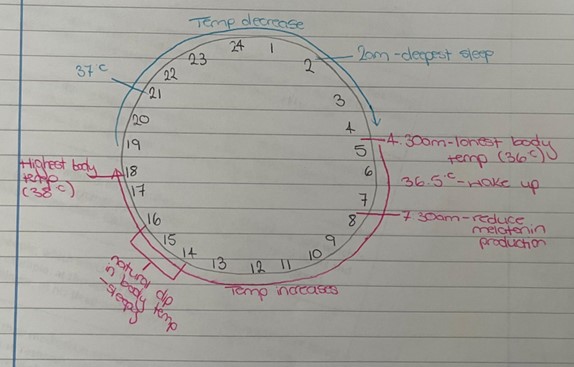
What is the first strength of circadian rhythms?
The idea that the sleep-wake cycle is a free running rhythm is supported by evidence from a case study of French geologist, Michael Siffre (1972)
What did this case study find?
After spending 179 days living in a Texan cave, deprived of environmental cause such as daylight, his sleep-wake cycle extended from the normal 24 hours to between 25-32 hours, although he continued to fall asleep and wake up on regular basis
What additional evidence is there from Aschoff and Wever (1976)?
Found that after spending 4 weeks in an underground WW2 bunker, deprive of natural daylight and clocks, all but one of the pps (whose sleep-wake cycle was extended to 29 hours), displayed a circadian rhythm of between 24-25 hours
How does this evidence support CRs?
Supports the idea that for most people the natural sleep-wake cycle is slightly longer than 24 hours, although it is reset by exogenous zeitgebers such as daylight hours and mealtimes that are associated with the 24-hour day
However, why is the value of this evidence questionned?
Because whilst pps were isolated from clocks, radios an daylight, they had access to artificial light which is problematic as Czeisler (1999) was able to change pps CR’s down to 22 hour and up to 28 hours using dim artificial lighting alone
What is another contradictory point for this strength?
In addition, studies into the nature of CRs tend to involve small groups of people, which limits the extent to which meaningful generalisations can be made e.g. at the age of 60, Siffre found that his biological clock ticked slower than when he was younger, as his sleep-wake cycle often stretched to 48hrs